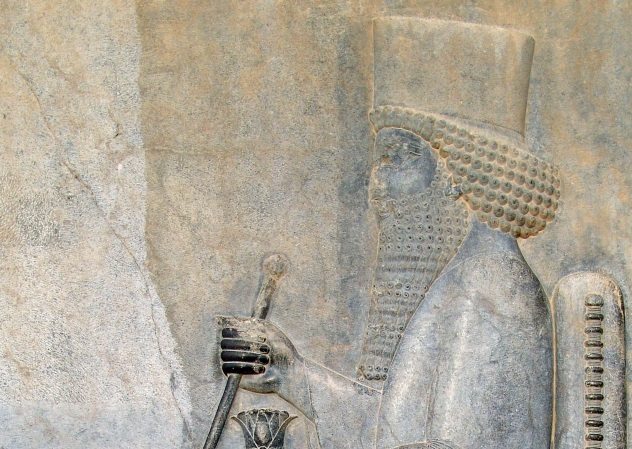 Mysteries
Mysteries  Mysteries
Mysteries  History
History 10 Surprising Stories About the Texas Rangers
 Humans
Humans 10 Philosophers Who Were Driven Mad by Their Own Theories
 Miscellaneous
Miscellaneous 10 Video-Game-Worthy Weapons and Armors from History
 Weird Stuff
Weird Stuff 10 Psychics Who Accurately Predicted Wartime Events
 The Arts
The Arts 10 Pieces of Art Inspired by a Broken Heart
 Health
Health 10 Science Fiction-Sounding New Medical Treatments
 History
History 10 Surprising Facts About the Father of Submarine Warfare
 Space
Space Ten Astonishing New Insights into Alien Worlds
 Weird Stuff
Weird Stuff 10 Bizarre Summer Solstice Rituals Still Practiced Today
 Mysteries
Mysteries Top 10 Haunting Facts About the Ghost Ship MV Alta
 History
History 10 Surprising Stories About the Texas Rangers
 Humans
Humans 10 Philosophers Who Were Driven Mad by Their Own Theories
Who's Behind Listverse?

Jamie Frater
Head Editor
Jamie founded Listverse due to an insatiable desire to share fascinating, obscure, and bizarre facts. He has been a guest speaker on numerous national radio and television stations and is a five time published author.
More About Us Miscellaneous
Miscellaneous 10 Video-Game-Worthy Weapons and Armors from History
 Weird Stuff
Weird Stuff 10 Psychics Who Accurately Predicted Wartime Events
 The Arts
The Arts 10 Pieces of Art Inspired by a Broken Heart
 Health
Health 10 Science Fiction-Sounding New Medical Treatments
 History
History 10 Surprising Facts About the Father of Submarine Warfare
 Space
Space Ten Astonishing New Insights into Alien Worlds
 Weird Stuff
Weird Stuff 10 Bizarre Summer Solstice Rituals Still Practiced Today
Ancient Persian Punishments Beyond Your Worst Nightmares
The Persian Empire believed in justice. They had strict and careful rules about sentencing a punishment for a crime. No one, they believed, should be executed for a first offense, and every criminal’s good deeds should be considered before handing down judgement. If someone was going to suffer, he should deserve it.
But if you did deserve it, the Persians made sure you paid for it. They came up with some of the most imaginative and brutal punishments in history. Justice in ancient Persia wasn’t always swift—it was a slow, prolonged, and painful torture torn from your worst nightmares.
10 Making A Chair Out Of Your Skin

When a Persian judge named Sisamnes was caught accepting a bribe, King Darius was determined to make an example out of him. The courts of Persia, Darius believed, should be impartial and fair. He was going to be sure that Sisamnes’s replacement didn’t make the same mistake.
Sisamnes was killed, but that was just the start. After his throat had been slit, Darius had the executioners flay off every inch of his skin and make them into strips of human leather. Then he had them sew together a chair made of Sisamnes’s skin.[1] From then on, the new judge would have to sit on a chair made of human flesh.
It gets worse: Sisamnes’s replacement was his own son. As he presided over Persia’s trials, he would have to spend every day sitting on a chair made of his father’s flesh. Now, King Darius believed, they would have a judge who would never forget what happened if he accepted a bribe.
9 Drowning In A Pool Of Ashes

One of the worst deaths you could suffer in ancient Persia was suffocation by ashes. It was a punishment reserved for the worst criminals: those guilty of high treason or offenses against the gods. And it was horrifying.
The Persians kept a 23-meter-tall (75 ft) hollow tower that was filled with nothing but ashes and wheels. At the top was a sliding platform, and the criminal would be taken to it and thrown in. He would plummet down into the center of the tower. The fall would likely break a few bones, but the ashes would keep him alive long enough to suffer the slower, more brutal death they had planned.
The executioners would turn the wheels. Men outside would put them into motion, swirling the ashes around to force them into the convict’s nose and mouth. He would inhale them, suffocating on burned ashes until he died.[2]
It’s a sentence more than a few people faced, and it even shows up in the Bible. In it, a corrupt Jewish priest is killed by the Persians in the tower of ashes. When he dies, his family isn’t allowed to bury his remains. “And that,” the Bible says to conclude the story, “was just what he deserved.”
8 Pouring Molten Gold Down Your Throat

When the Roman emperor Valerian was captured by Persian soldiers, he met a horrible end. He died a death that might sound like something pulled out of Game of Thrones. The real story, though, is much, much worse.
Persian emperor Shapur I kept Valerian as his personal slave. He would parade him in front of his army, his hands and legs shackled, treating him like a dog. He humiliated him every way he could. Before mounting his horse, Shapur would make Valerian get down on his hands and knees so that he could use him as a human stool.[3]
When Shapur got bored of his toy, he killed him. He poured molten gold down Valerian’s throat. Then he had the emperor of Rome taxidermied. Valerian was skinned and stuffed with straw, and his dead body was put on display in a Persian temple—a trophy of gold and human remains.
7 Tearing People Apart With Trees

In the later years of Persia, thieves had to deal with horrifying punishments. Anyone caught stealing or harassing a rider on the roads of the empire was sentenced to death—by being torn in half.[4]
The executioners would pull the tops of two trees as close to one another as they could and tie them together. They would drag the convict over and tie one leg to the top of each tree. Then they would cut the cord holding the trees together.
The two trees would spring free, pulling apart at incredible speeds and shooting back upright with the criminal still tied to them. His body would tear in half from the force. Within a second, two halves of what was once one man would hang from the trees.
His body would be left there, hanging over the road where he’d robbed an innocent person. Anyone who passed through these parts, the Persians believed, would get a harsh reminder of just what would happen if they followed the lives of thieves.
6 Crushing Your Servants’ Heads With Stones

As much as Persia tried to be fair about its crimes, they didn’t exactly ignore class status. The king could get away with anything, and as long as they were in his good books, his family could, too. When King Artaxerxes II’s own mother murdered his wife, he couldn’t bring himself to execute her—so he killed her servants, instead.
Parysatis, Artaxerxes’s mother, hated her daughter-in-law Stateira, and Stateira hated her right back. They had to pretend to be civil in public, but they tried to kill each other so often that Artaxerxes had to set up rules to keep them from pulling it off. When they dined together, he ordered that everything they ate had to be cut in two and shared so that they couldn’t poison each other.
It didn’t work. Parysatis had poison put on one side of a knife and had her servant use it to cut the meat, poisoning the half that went to Stateira and keeping her half untainted. It worked, and the king’s mother murdered the queen.
It was obvious, of course, who was responsible, but Artaxerxes couldn’t bring himself to kill his mother. He had all her servants tortured until they confessed. Then he had the meat cutter’s head smashed in with a rock.[5] Parysatis, though, was just sent into exile.
It didn’t take long before Artaxerxes invited her right back. And she helped him pick a new wife: Parysatis convinced Artaxerxes to marry his own daughter.
5 Chaining Dismembered People To Gates

It was fairly common in Persia and the nations around it to torture rebels by cutting off their noses and ears.[6] That kind of brutal torture, though, wasn’t always a death sentence. Sometimes, they kept you alive. And sometimes, that was worse than death.
When the people revolted against King Darius, he made sure everyone knew what would happen if they turned against him again. He rounded up the rebel leaders and cut off their noses, ears, and tongues and plucked out one of each of their eyes—but he didn’t kill them. Not yet.
The rebel leaders were chained up and bound to the front gate of his castle so that everyone who walked by it would see their mutilated bodies. Their lieutenants, meanwhile, were decapitated, and their heads were hung from the top of the city citadel.
They were left there for weeks, being jeered and beaten by everyone who walked by, staring at the remains of their friends and suffering in excruciating pain. Then, when they couldn’t take anymore, they were allowed to die.
4 Making The Slaughter Of Your People An Annual Holiday

In Persia, Zoroastrian priests were called the Magi. This didn’t necessarily mean that they had magical powers; they were religious leaders. And after one of them got a little overambitious, their jobs became hell.
A Magi named Smerdis tricked the people into believing he was the son of Cyrus the Great and got himself crowned as king of Persia. He was actually a great king, loved by his people. He introduced tax reforms that made life easier and relaxed the laws on military conscription—but he stole the throne, so naturally, he had to die.
When the people found out, they didn’t stop at murdering Smerdis. They ran through the streets of the kingdom, spreading the word and murdering every member of the Magi they could find.[7]
When the massacre was over, the people decided to make it an annual event. Once every year, the Persians celebrated a holiday called “the Slaughter of the Magi.” On the anniversary of Smerdis’s death, they would run through the streets, and if they caught any Magi outside, they would brutally murder them.
3 Letting Insects Eat You Alive
 Scaphism might already be the best-known of the Persian punishments, but the list would be incomplete without it. Few tortures compare.
Scaphism might already be the best-known of the Persian punishments, but the list would be incomplete without it. Few tortures compare.
This torture was reserved for people the king really hated. The victim would be stripped naked and put inside of a hollowed-out tree trunk or two boats, with his heads, hands, and feet sticking out and exposed to the Sun. Then he would be force-fed milk and honey until he had diarrhea and became literally buried in his own filth.
The torturers would rub honey over the exposed parts of his body to lure over insects. Bugs would crawl over the convict and slowly eat away at his flesh, while wasps would agonize with their stingers until he prayed for death.[8]
The torturers, though, would continue to force-feed him to keep him alive for as long as possible. After a few days, the victim’s mind would start to deteriorate, but he would still be alive. It could take weeks before his body finally gave out and died. The first time they tried it, it took 17 days of agony and praying for death before the victim’s prayers were finally answered.
2 The Triple Death

Some people, the Persians believed, deserved more than one death. If their crime was terrible enough, they wouldn’t settle to kill them once. They’d make them die three deaths before they were allowed to stop breathing.
The victims wouldn’t actually die, but they would go through the agony of death three times. When a eunuch angered the wife of Cyrus the Great, for example, she first had his eyes pulled out of his head. Then, once he’d recovered, she had him flayed alive. Then they nursed him back to health again before finally crucifying him.[9]
It wasn’t the only time it happened. After a soldier tried to take credit for killing Cyrus the Younger in battle when he’d really only wounded him, the king ordered his execution. The king’s mother, though, intervened, saying, “Leave him to me, and he shall receive the fitting reward for his daring words.”
First, she had him stretched out on the wheel for ten days. Then she gouged out his eyes. And then, finally, she finished him off—by pouring molten brass into his ears until he died.
1 Forcing People To Eat Their Children

A Median general named Harpagus went through the worst punishment possible for the lightest offense. King Astyages had a dream that his grandson would overthrow him, so he ordered Harpagus to take the infant out into the wilderness and leave him to die. Harpagus, instead, gave the baby to a shepherd, who raised the child as his own.
It took ten years for Astyages to find out he’d been disobeyed, but when he did, he was vicious. He cut Harpagus’s son’s throat, chopped him from limb to limb, roasted his flesh, and served him to Harpagus at a banquet.
At first, Harpagus didn’t know what he was eating or even that his son was dead. Astyages, however, made his servants put the dead boy’s head on the table in front of him and taunted him, saying, “Do you know what beast’s meat you have eaten?”
Harpagus knew what would happen to him if he tried to take revenge. He couldn’t even dare to cry in front of the king who had murdered and fed him his own son. “I know,” Harpagus was forced to say, “and all that the king does is pleasing.”[10]
He complimented Astyages on the dish and asked to take the rest with him. Then he carried what they’d let him take back to his home and buried the last remains of his son.
Read more horrific punishments from the past on 10 Forgotten And Intriguing Punishments From History and 10 Ancient Punishments That Didn’t Fit The Crime.








